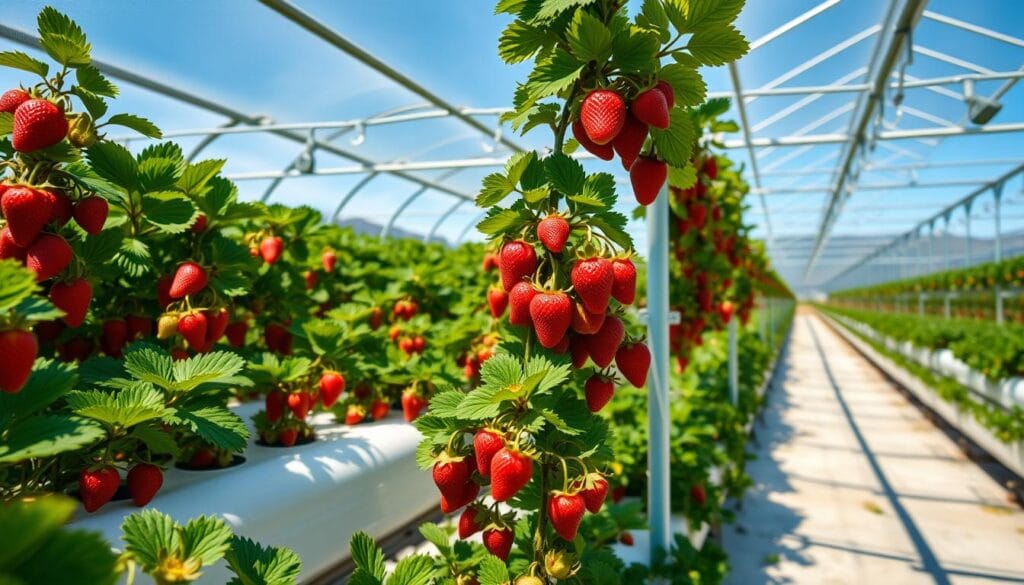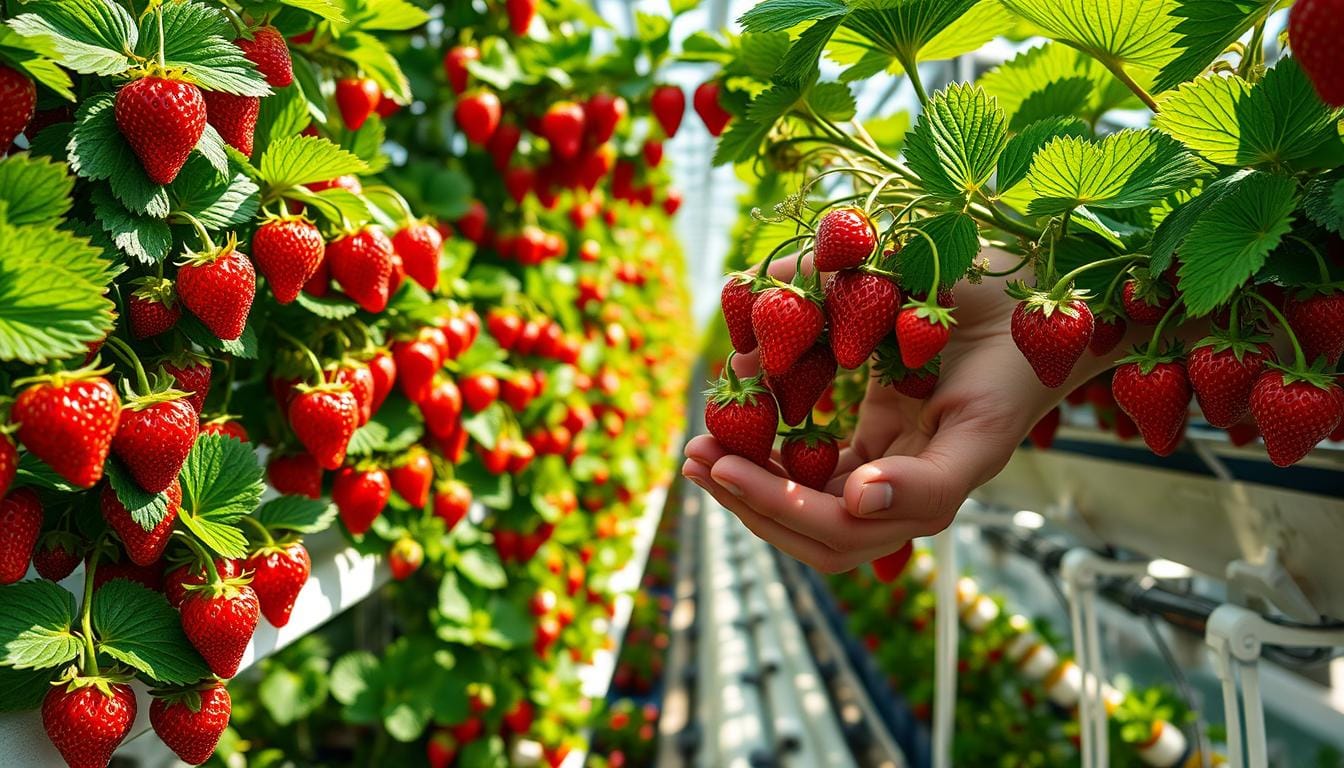Harvesting Hydroponic Strawberries is an exciting step in your journey to cultivating these delicious fruits. Understanding the fundamentals of harvesting is essential for achieving a bountiful yield. This approach highlights the significance of hydroponics in sustainable farming, where strawberries are grown using nutrient-rich solutions instead of soil, offering an innovative and efficient way to produce healthy crops.
This article will guide you through 5 easy steps to harvest tasty hydroponic strawberries. Harvesting strawberries hydroponically needs careful planning and the right techniques. With these steps, you’ll get a lot of fresh, tasty strawberries and help the planet too.
Key Takeaways
- Hydroponic strawberry harvesting offers a sustainable and efficient way to grow strawberries
- Best practices and techniques are essential for achieving a high yield
- Hydroponic systems provide a controlled environment for growing strawberries
- Nutrient-rich solutions are used instead of soil in hydroponic strawberry harvesting
- Following the 5 proven steps can help you achieve a successful harvest
Understanding Hydroponic Strawberry Systems
Exploring hydroponic strawberry cultivation is exciting. It’s key to know the various hydroponic systems out there. These systems are great for sustainable farming, using resources wisely and harming the environment less. Indoor farming is also popular for its high yields and small land use.
For growing strawberries hydroponically, you have several systems to pick from. These include Nutrient Film Technique (NFT), Ebb and Flow, and Drip Irrigation. Each has its own good points and downsides. The right choice depends on your needs and what you have available.
Types of Hydroponic Systems for Strawberries
- Nutrient Film Technique (NFT): This system keeps a steady flow of nutrient-rich solution to the plants’ roots.
- Ebb and Flow: It uses a pump to fill the grow tray with nutrient solution, then drains it back into the reservoir.
- Drip Irrigation: This method sends nutrient solution directly to the plants’ roots through a network of tubes and drippers.
Hydroponic strawberry growing has many advantages. It saves water, uses less land, and boosts yields. By using hydroponic systems, you help the environment and get a lot of tasty strawberries.
Benefits of Hydroponic Strawberry Growing
Hydroponic strawberry growing has several benefits:
- Water conservation: Hydroponic systems use much less water than traditional farming.
- Increased yields: They can produce more because of the exact control over nutrients and conditions.
- Reduced land use: Hydroponic systems work well in indoor farming, needing less land.
Knowing about different hydroponic systems and their benefits helps you make smart choices. Whether you’re new or experienced, hydroponic systems are a good way to farm sustainably indoors.
Preparing Your Hydroponic Setup for Maximum Yield
To get high yields of organic strawberries, you need to set up your hydroponic system right. Choose a strawberry type that does well in hydroponics and yields a lot. ‘Albion’ and ‘Camarosa’ are good choices for this.
Make sure your growing medium is top-notch and made for hydroponics. This ensures your strawberries get all the nutrients they need to grow well. Optimizing the nutrient solution is key for their health and growth.
When setting up your hydroponic system, consider a few important things:
- Lighting: give your strawberries the right light amount and type.
- Temperature: keep it between 65-75°F (18-24°C) for best growth.
- Humidity: aim for 40-60% to keep things just right.
By setting up your hydroponic system well and optimizing growing conditions, you create a perfect spot for your strawberries. This leads to a high yield and tasty, healthy strawberries.
Getting a high yield of organic strawberries takes planning and attention. Follow these steps and give your strawberries the care and nutrients they need. Then, you’ll enjoy a big harvest of fresh, tasty organic strawberries.
The Science Behind Hydroponic Strawberry Harvesting
Exploring hydroponic strawberry growing requires understanding the science behind it. This knowledge helps optimize your indoor farm and boosts your yield. The success of harvesting hydroponic strawberries depends on nutrient balance, environmental conditions, and pH management.
During the fruiting stage, strawberries need specific nutrients for healthy growth. Macronutrients like nitrogen, phosphorus, and potassium are key. Providing the right amount ensures your plants grow well.
Nutrient Requirements During Fruiting Stage
- Nitrogen: essential for leaf growth and development
- Phosphorus: critical for root growth and fruit formation
- Potassium: important for plant health and disease resistance
It’s also vital to create the right environment for your strawberries. This includes keeping a steady temperature, humidity, and light schedule. By following these tips, you can create the perfect space for your plants to flourish.
Optimal Environmental Conditions
By grasping the science of hydroponic strawberry harvesting, you can elevate your indoor farming. Enjoy a rich harvest of tasty and nutritious strawberries.
| Factor | Optimal Range |
|---|---|
| Temperature | 65-75°F (18-24°C) |
| Humidity | 50-60% |
| Lighting | 12-14 hours of daylight |
Identifying the Perfect Harvesting Time
When you’re growing hydroponic strawberries, knowing when to harvest is key. This ensures your strawberries are both tasty and of high quality. In vertical farming, you can watch your strawberries grow closely. Look for a bright red color with no white spots to know they’re ripe.
For the best taste, pick strawberries that are firm but soft to the touch. This means they’re perfectly ripe. Also, keep in mind that different strawberry varieties have their own best times to pick. Learning when to harvest is essential for a great crop of healthy, tasty strawberries.
Some important things to think about when picking the right time include:
- Color: Bright red with no white spots
- Texture: Firm but yields to pressure
- Firmness: Slightly soft to the touch

Vertical farming with hydroponics makes it easier to know when to pick. By watching your strawberries grow, you can pick them at the perfect time. This way, you get the best results from your hard work.
| Factor | Description |
|---|---|
| Color | Bright red with no white spots |
| Texture | Firm but yields to pressure |
| Firmness | Slightly soft to the touch |
Essential Tools and Materials for Harvesting
Getting ready to harvest your hydroponic strawberries? You’ll need the right tools and materials for a successful harvest. Choosing hydroponic systems that focus on sustainable agriculture helps the environment. Here are a few must-haves:
- Biodegradable containers for collecting and storing your strawberries
- Organic pest control methods to prevent damage to your crops
- A sharp, clean harvesting tool to minimize waste and prevent contamination
Using eco-friendly materials and tools helps reduce your environmental impact. It also supports a healthier growing process. This is key in hydroponic systems, aiming for a closed-loop ecosystem. As you dive into sustainable agriculture, the right tools and materials are vital for a successful harvest.
Harvesting efficiently and reducing waste is the goal. With the right tools, you can collect and store strawberries easily. This keeps them fresh and healthy. Whether you’re new or experienced, investing in hydroponic systems and sustainable agriculture promotes a healthier food system.
Professional Hydroponic Strawberry Harvesting Techniques
Learning to harvest hydroponic strawberries is key to a successful crop. The right techniques help keep your strawberries fresh and healthy. This way, you can enjoy them for longer and reduce waste in your indoor garden.
It’s important to handle strawberries carefully to avoid bruising. Use gentle methods like twisting the stem or cutting it with scissors. This method helps prevent damage and keeps the fruit fresh.
Post-Harvest Handling and Storage Best Practices
After picking, strawberries need careful handling to stay fresh. Keep them in a cool and dry location, ensuring they are protected from direct sunlight and humidity. Use containers or bags that let air in and keep humidity right.
By using these expert techniques, your indoor strawberry farm will thrive. Always focus on gentle handling, proper storage, and upkeep. This ensures a healthy and abundant harvest.
Troubleshooting Common Harvesting Issues
When you’re growing hydroponic strawberries, you might run into some common problems. These can affect how many strawberries you get. To get a high yield of tasty strawberries, it’s key to follow best practices and keep an eye out for issues. Keeping your growing space clean and healthy is vital to avoid pests, diseases, and nutrient problems.
Here are frequent problems and effective solutions for addressing them:
- Pests: Check your plants often and use natural pest control when needed.
- Diseases: Keep your growing area clean and remove sick plants to stop disease from spreading.
- Nutrient deficiencies: Test your nutrient solution regularly and adjust it if needed to make sure your plants get what they need.
By sticking to best practices and being proactive, you can beat these problems. This way, you’ll enjoy a high yield of yummy hydroponic strawberries. Always put your plants’ health first, and ask for help if you’re not sure about anything in the harvesting process.
Maximizing Your Hydroponic Strawberry Yield
To get the most out of your hydroponic strawberries, use strategies for ongoing growth, crop rotation, and quality checks. These methods help you have a steady supply of organic strawberries. They also reduce harm to the environment. Using vertical farming is a key part of this approach.
Think about mixing hydroponics with organic farming. This means using natural pest control, composting, and rotating crops. For instance, grow strawberries with lettuce or herbs to fight off pests and diseases.
Continuous Production Strategies
Plant new strawberry crops regularly to keep a steady supply. Vertical farming is great for this because it lets you grow many plants in a small area. This way, you can increase your harvest and cut down on waste.

Crop Rotation Tips
The practice of rotating crops helps maintain the fertility of the soil while also reducing the risk of plant diseases. By switching up your strawberry crops with other plants, you can avoid pests and diseases. Here are some tips for crop rotation:
- Switch your strawberry crops with plants that need different things to grow
- Make a crop rotation plan to know when to plant and harvest
- Use cover crops to make the soil better and stop erosion
By using these strategies, you can boost your hydroponic strawberry yield. Enjoy a steady supply of organic strawberries. Always choose sustainable methods like vertical farming to protect the environment and keep your growing space healthy.
Conclusion: Your Path to Successful Hydroponic Strawberry Growing
Learning about hydroponic strawberry harvesting is a journey that’s both fun and rewarding. You now have the knowledge to grow a healthy hydroponic strawberry garden. Just follow the 5 steps we shared.
To get the most from your hydroponic strawberry yield, stick to the best practices. Keep an eye on nutrient levels and make sure the environment is just right. Also, harvest your berries carefully. This way, you’ll enjoy a steady supply of fresh, tasty strawberries at home.
Keep exploring and learning as you grow your hydroponic strawberry garden. Seeing your plants flourish and enjoying a fresh strawberry is incredibly rewarding. Every effort you make will be worth it.
Use hydroponic technology to your advantage. It will help you achieve a successful and sustainable hydroponic strawberry harvest. Happy growing!

